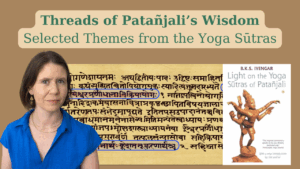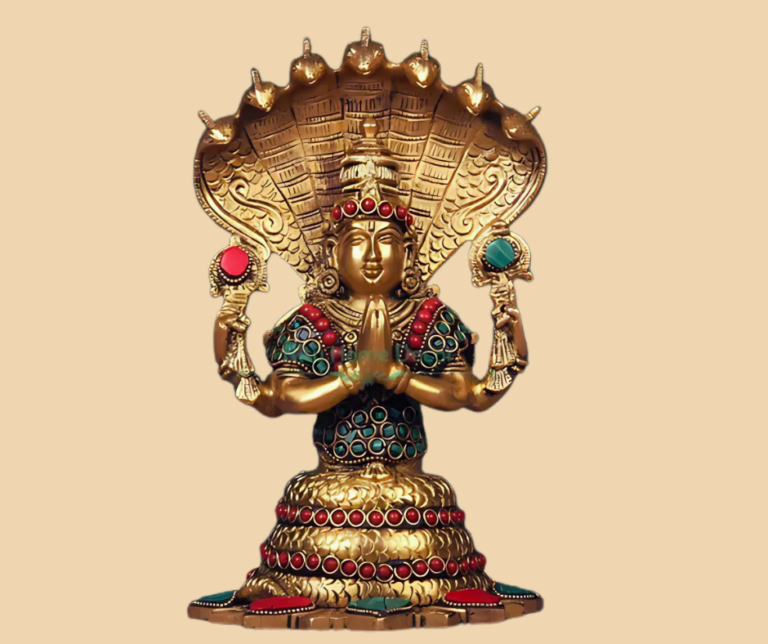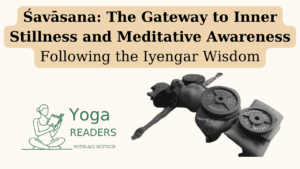
Threads of Patanjali’s Wisdom – Online Course
A course of selected themes from the Yoga Sutras with Dr. Agi Wittich The Yoga Sūtras of Patañjali are the philosophical heart of yoga.

Who was Pātañjali (पातञ्जलि)?
His legacy endures not just in his individual works, but in their synthesis – showing us how grammar, medicine, and yoga are not separate disciplines but interconnected paths to understanding the mystery of human existence. From his miraculous birth in his mother’s hands to his comprehensive illumination of human knowledge, Patanjali’s story reminds us that the greatest wisdom comes from integration – of body, mind, and spirit.
This integration began with his very birth, through a miracle that would foreshadow his extraordinary destiny:
In ancient India, there lived a remarkable woman named Gonikā. She was no ordinary woman – she was both a tapasvinī (an ascetic) and a yoginī, who had accumulated vast oceans of spiritual knowledge through years of dedicated practice. But Gonika faced a profound dilemma. Despite her great wisdom, she couldn’t find a single worthy student to whom she could pass on her precious knowledge.
One day, overwhelmed by this predicament, Gonika turned to the sun god himself. Standing in prayer, she cupped water in her palms as an offering. With deep devotion, she spoke to the divine: “This knowledge has come through you, so let me give it back to you.” What happened next would become the stuff of legend.
As she opened her eyes, still holding the water in her anjali mudra (prayer position), she witnessed something extraordinary – a tiny movement in her palms. There, mysteriously manifested, was a small being: Patanjali. The name itself would forever commemorate this miraculous moment – Pata (पत) meaning fallen, and Añjali (अञ्जलि) marking the sacred time of prayer.
What followed was one of the most remarkable intellectual and spiritual journeys in Indian history. Patanjali would go on to master and illuminate three distinct fields of knowledge, each one deeper than the last.
First came grammar. With extraordinary insight, Patanjali composed the Mahābhāṣya, a masterwork that would become one of the cornerstones of Sanskrit grammar. But this wasn’t just a dry academic text – it was a living document that captured the pulse of ancient Indian society, its customs, and its wisdom. Through its pages, Patanjali showed how language itself was a gateway to understanding consciousness.
The Mahabhasya is a comprehensive commentary on Panini’s Ashtadhyayi and Katyayana’s Varttika. This monumental work remains one of the three foundational texts of Sanskrit grammar (vyākaraṇa). It’s not just a grammatical text but also contains valuable information about the social, cultural, and political conditions of ancient India. The Mahabhasya is definitely attributed to Patanjali and is dated around 2nd century BCE.
His quest for knowledge then led him to the human body. Through his study of dance movements, he began to understand the intricate workings of the human form. Some say this led him to write the famous Caraka Saṃhitā, a comprehensive guide to Ayurvedic medicine, though this remains a matter of scholarly debate. Iyengar notes that “some think that the famous Charaka Samhita, a treatise on ayurvedic medicine, was written by Patanjali and that Charaka was his pen-name, but others say that Patanjali had no knowledge of medicine.”
The Charaka Samhita is one of the principal texts of Ayurveda. If indeed written by Patanjali (though this remains debated), it shows remarkable understanding of human anatomy, disease, diagnosis, and treatment. The text contains knowledge about physiology, etiology, pathology, prognosis, and various aspects of treatment and medicine.
But even after these monumental achievements, Patanjali felt his work was incomplete. As the text tells us, he realized he “had not touched on consciousness.” And so began his most profound work – the Yoga Sūtras. Beginning with the famous words “Yogaś citta-vṛtti-nirodhaḥ” (yoga is the stilling of the movements of consciousness), he created a masterpiece that would guide seekers for millennia to come.
The Yoga Sutras unfolded like a map of consciousness itself. In the Samadhi Pada, he explored the mysterious landscapes of the mind. Through the Sadhana Pada, he illuminated the path of practice and the obstacles that await the seeker. In the Vibhuti Pada, he revealed the extraordinary powers that await the dedicated practitioner, while warning against becoming attached to them. Finally, in the Kaivalya Pada, he described the ultimate goal – complete liberation.
The Yoga Sutras, composed of 196 aphorisms, is considered the foundational text of classical yoga philosophy. It systematically outlines the science of yoga, including the eight limbs (ashtanga), obstacles to practice, and the ultimate goal of self-realization. This text has profoundly influenced yoga philosophy and practice worldwide.
Some scholars question whether one person could have mastered such diverse fields. Iyengar acknowledges the scholarly debate about whether these works were written by the same person. However, he offers an interesting defense through comparison with Sri Aurobindo: “we know that in modern times a great soul such as Sri Aurobindo could write hundreds of poems every day, and that this tremendous capacity increased when he did yoga, so it need not surprise us that Patanjali, who was a great integrated soul in his own day, could write major treatises on grammar, medicine and yoga, though all three are very complex and difficult subjects.”
This multifaceted contribution to Indian knowledge systems – covering language (grammar), body (medicine), and spirit (yoga) – showcases Patanjali’s comprehensive understanding of human existence and its various dimensions. Whether one or multiple authors, the works attributed to Patanjali have profoundly shaped Indian intellectual and spiritual traditions. Like a master key that opens many doors, Patanjali’s integrated consciousness allowed him to perceive and articulate the deep connections between language, health, and spiritual liberation.

A course of selected themes from the Yoga Sutras with Dr. Agi Wittich The Yoga Sūtras of Patañjali are the philosophical heart of yoga.

In a recent Yoga Readers session, Dr. Lois Steinberg opened her teaching archives and personal memories, sharing stories that span four decades of study

In the vast and intricate repertoire of yoga āsanas (postures), Śavāsana (Corpse Pose) holds a unique and profoundly significant position. Often superficially perceived as
Agi Wittich is a yoga practitioner since two decades, and is a certified Iyengar Yoga teacher. Wittich studied Sanskrit and Tamil at the Hebrew University of Jerusalem, Israel, completing a PhD with a focus on Hinduism, Yoga, and Gender. She has published academic papers exploring topics such as Iyengar yoga and women, the effects of Western media on the image of yoga, and an analysis of the Thirumanthiram yoga text.